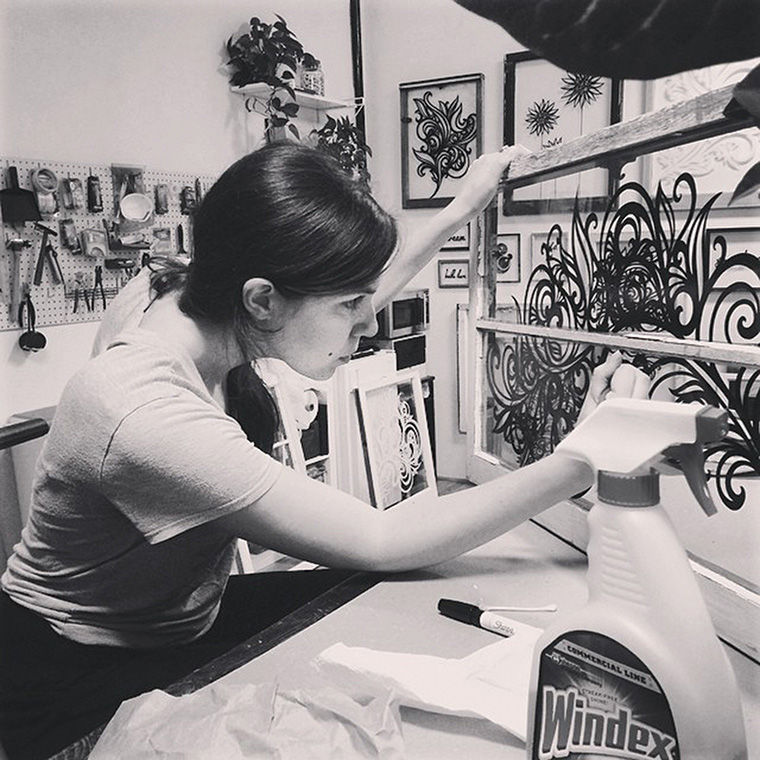Local artist puts her mark on Chicago’s art scene
Photo Courtesy of Emmy Star Brown
Emmy Star Brown creates her marker artwork using items found at flea markets and thrift shops around town.
April 13, 2015
Emmy Star Brown is one of Chicago’s rising artists. Throughout the last several years, Brown has made a name for herself on the Chicago art scene by taking other people’s discarded belongings that she finds at thrift shops or flea markets and giving them new life with her extraordinary marker-drawing style.
In her time as a young artist, she has already been sponsored by Sharpie, which led to her creating designs using Sharpie markers for the company’s 2012–2013 national ad campaign. Her work has also been commissioned by Lululemon and Red Bull, and she recently won a contest to design a custom shoe print for the Chicago-based sneaker company BucketFeet.
The Chronicle spoke with Brown about getting her start as an artist, working with Sharpie and using windowpanes as canvases.
THE CHRONICLE: When did you first fall in love with art?
EMMY STAR BROWN: I’ve been drawing my whole life. My dad was a middle school art teacher for 35 years, so I grew up around art. My earliest memories are going to restaurants and diners with him and drawing on napkins. A lot of his art revolves around creating sculptures made from found objects. He was always collecting materials and interesting things to build from flea markets, and that became a big part of my childhood. When I started developing my work, I really wanted to bring that aspect into my art. Shortly after I moved to Ukrainian Village in the city and started collecting frames—window frames and picture frames and any materials that I could reuse in the alleys—it really resonated with me and people were really drawn to it. Once I started showing them and sticking to that one thing, that’s how I really made a name for myself.
CC: Why do you use windows and frames as canvases?
I’m really drawn to the contrast between the modern clean-line work combined with these old, salvaged, rustic frames. The great thing about working with glass is that everything I’m painting, you’re seeing a mirror image of because it’s all done on the backside. Depending on where they’re hung and the placement, sometimes you’ll get a really beautiful shadow and other times you won’t get a shadow at all. I love that aspect of it.
CC: What is it like to be a part Chicago’s booming underground art scene?
It’s awesome. I feel like the Chicago art scene is very small. As time goes on, I feel like everyone is just connected to everyone else somehow, even if it’s just by going to shows or going to Galerie F. It’s really neat. Galerie F, particularly, is awesome because it’s really doing something that other galleries haven’t done, which is representing artwork that is done on the street. They give artists opportunities to boost their careers and get the exposure to reach different audiences. I’ve collaborated with a few other artists and street artists through [Galerie F].
CC: How did your Sharpie sponsorship come about?
In 2012, Sharpie was working through an agency downtown, and the agency was looking for two artists to represent different Sharpie products. It was pure luck. They scouted me to represent them and their Sharpie Metallics. I was chosen to represent them for one full year in their advertising campaign. I was in their ads and commercials for a year, which was incredible exposure. It was a national campaign, so it was the key thing that pushed me from being this struggling artist to being a full-time artist.
CC: Did that campaign help expose you to a wider fan base?
Totally. I think the average age group for the Metallics was geared toward 13–18 year olds, so I got this huge wave of teenagers who started emailing and texting and sending messages and sending me their artwork constantly. It was really cool to hear their stories and how inspired they were from my work.
CC: How do you describe your process?
For my abstract pattern work, it’s very impulsive. There’s not very much planning. It’s really all about finding a starting point and getting in the zone and going from there. With a lot of my art, I try not to intentionally plan and rather be in the moment with it.








